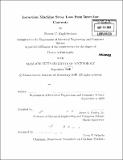Induction machine stray loss from inter-bar currents
Author(s)
Englebretson, Steven Carl
DownloadFull printable version (10.57Mb)
Other Contributors
Massachusetts Institute of Technology. Dept. of Electrical Engineering and Computer Science.
Advisor
James L. Kirtley, Jr.
Terms of use
Metadata
Show full item recordAbstract
Stray load loss refers generally to the sources of induction machine loss not accounted for by typical calculations of primary or secondary copper loss, no load core loss, or friction and windage loss. Harmonic rotor bar currents from the non-sinusoidal distribution of the slotted stator winding contribute significant stray load loss. Rotor bars, especially on cast rotors for machines under fifty horsepower (37.3 kW), can be skewed, helically twisted from one end to the other, to reduce loss, torque, and noise from alignment of rotor and stator slots and from harmonic rotor currents. Interbar currents flowing circumferentially through the laminations between skewed and non-insulated rotor bars can significantly increase stray load loss. Presented equations adjust the effective rotor resistance and skew factor of the extended per-phase induction machine equivalent circuit model in order to account for the impact of inter-bar currents. The average value of resistance between neighboring rotor bars significantly impacts calculations of rotor bar and inter-bar current and loss and has been determined for a number of measured rotors. Rotors fit into one of two distinct categories where either the bar-to-lamination contact resistance dominates the inter-bar resistance or the total resistance divides more equally between values of bar, lamination, and contact resistance. Performance calculations using the adjusted equivalent circuit model are verified theoretically against previous calculation methods and experimentally by comparison to measured test results including variations in rotor skew, conductor conductivity, and inter-bar resistance. (cont.) A number of different cast copper and aluminum five and ten horsepower test induction motors performed differently than originally predicted and variably between nominally identical machines. Inter-bar currents are part of the cause of both the variation and additional losses measured on these machines. The adjusted equivalent circuit equations improve estimations of motor performance and allow identification of means to increase machine efficiency by minimizing the stray load loss due to inter-bar currents.
Description
Thesis (Ph. D.)--Massachusetts Institute of Technology, Dept. of Electrical Engineering and Computer Science, 2009. Copyright and degree dates have handwritten change on title-page from 2008 to 2009. Cataloged from PDF version of thesis. Includes bibliographical references (p. 175-178).
Date issued
2009Department
Massachusetts Institute of Technology. Department of Electrical Engineering and Computer SciencePublisher
Massachusetts Institute of Technology
Keywords
Electrical Engineering and Computer Science.